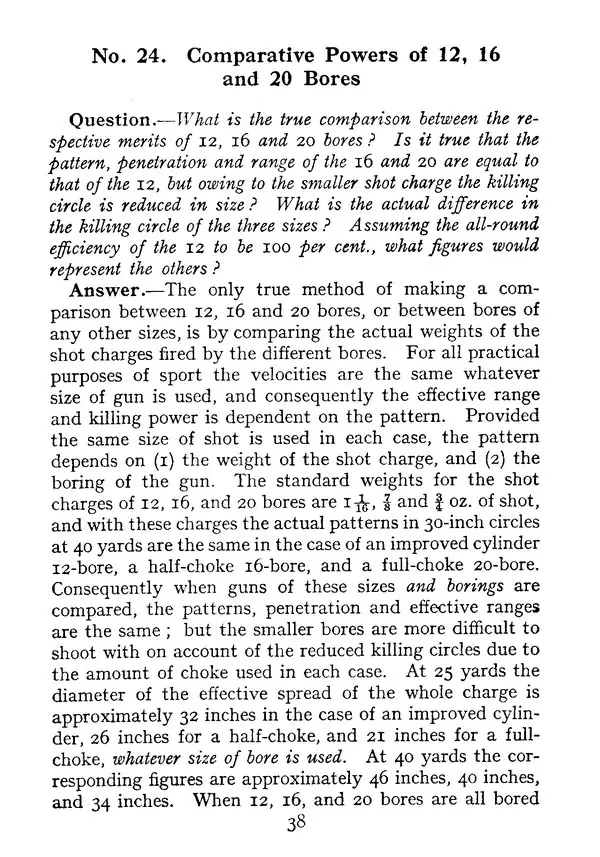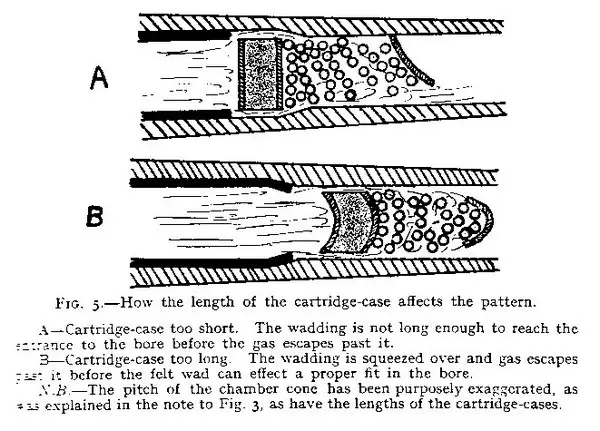|
Shotgun Barrels and Patterns, 120 Years Later Many will be surprised, if not astounded, to discover that very, very little has changed as far as shotgun barrel design, and shotgun pattern performance, over the last one hundred and twenty years. The .729 inch 12 gauge bore was a settled matter as far as the British were concerned in the late 1800's, the notion of bore having originated with cannon. Different forcing cone lengths were touted and deeply experimented with in the late 1800s as well, and standards for pattern performance were also a settled matter around the turn of the century as well. Bob Brister's Shotgunning: The Art and the Science (1976) is an exceptionally good reference work, a book every shotgun enthusiast should have. However, much of the information in this excellent tome was over seventy-five years old by the time Mr. Brister presented it again. The accepted British system of choking is quite simple. A “40 points” choke constriction (.040 inch) is Full Choke, .030 is three quarters choke, .020 inch is half-choke, .010 inch is quarter-choke. Various forcing cone lengths to 4 inches and beyond, were widely used and experimented with. Over-sized bores were also widely tried and the results carefully documented. What it takes for a truly rigorous test of pattern performance was discussed in a formal lecture in April, 1897.
Having answered common question for ten years or so in The Field, Major Sir Gerald Burrard wrote a condensed summation in 1930 in his book IN THE GUNROOM. One of the popular questions he entertained was about the comparative powers of different gauges. Just as it is today, it is directly payload-related.
The
standard 12 gauge wingshooting load of the day was a 1-1/16 oz.
payload. Up to 70% full choke 40 yard patterns were common, up to 80%
if
the ballistics were lowered, as in very low velocity loads. Once folded
crimps became prolific, 75% full choke pattern efficiency became
standard, and so it is to present day. The extreme
killing range of a "regular" 12 bore was discussed, noting that British
#6 lead shot (American #7 lead) was effective to 70 yards on most
birds, but pattern thinning made 50 yards a more reasonable limit.
This was with the 1-1/16 oz. hunting load, not with 1-1/4 oz. - 1-3/8
oz. hunting loads commonly in use in the United States for the last
ninety years. English #6 shot is about 291 pellets to the ounce, yielding roughly 309 pellets for the 1-1/16 hunting load. While American #6 is about 218 pellets to the oz., a 1-3/8 oz. payload brings the more lethal pellet count to about 300, offering more smashing and penetration ability at all ranges. The British 1-1/16 oz. load was not arrived at without thought or purpose, for the discussion centered about fixed breech guns and what most shooters felt was a reasonable recoil level for the standard 2-1/2 inch chambered double barrel 12 gauge, with a weight of 6 - 6-1/2 pounds. While certainly 3 inch chambered 12 (and 16 gauge) shotguns were available in the 1930s and earlier, the 2-1/2 inch 12 was the standard British game gun. It wasn't that British gunmakers were unaware of heavier payloads and large bores at all, for 4 bore, 8 bore, and 10 bore shotguns were produced and extensively tested. The British double 10 gauge's suggested weight was 8-1/2 pounds, minimum. The eight gauge was suggested to be between 13 and 15 pounds. A severe omission by W. W. Greener, Major Burrard, and other great contributors was their almost total ignorance of John M. Browning and repeating shotguns. Despite the widespread use of the Winchester Model 1897 (and its role in WWI), the Browning Automatic-Five (1902), and the Winchester Model 1912 . . . according to Greener and Burrard, to their discredit, you would think that these prolific models never existed.
In all of these years, the fundamentals of shotgun performance have not changed substantially. Large bores and long forcing cones were old news, even a century ago. Major Burrard, and others, made it quite clear that the shotshell unfolded length (above) should match the bore for the most consistent results. The felt wad was always the weak link. Whether blown patterns, cartwheel patterns, erratic velocities . . . cheap felt wads were invariably the culprit. The classic rattle cartridges feature pellet abrasion from jostling down the bore, scrubbing directly against the barrel steel. The Winchester Mark V collar of 1962 eliminated all this, and two years later the Remington Power Piston of 1964 bettered shotshell performance for good. The Power Piston also eliminated the need, much less any desire, for long forcing cones, as the peripheral pellets that hit the forcing cone were already traveling at comparatively low velocity and now, no pellets made direct contact with the forcing cone or barrel at all. Clearly, what has improved is the ammunition, with non-corrosive primers, far better wads, higher efficiency propellants (as opposed to the old 33 grains of Smokeless Diamond to get 1-1/16 oz. out of your muzzle, today 17 grains of Red Dot can do the same, with a heavier 1-1/8 oz. load). We have also seen the elimination of hand work in favor of CNC machining that doesn't get hungry, tired, and doesn't want overtime pay. What hasn't improved in large measure are the aesthetics, for some of today's shotguns are among the most repugnantly ugly smoothbores ever to appear. The enjoyable and effective shotgun is still the one that shoots to point of aim, has tolerable recoil for the individual, is well-balanced, fits and comes up for the individual supremely well, and is pleasing to the eye. Those attributes have never fallen from favor . . . in the last 120 years. |


